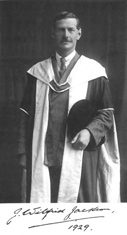By R. M. C. E.

J. W. Jackson was born in Scarborough, but soon moved with his family to Manchester, where he was educated. He entered first the cotton, then the woollen trade and continued his education by evening class work at the Manchester School of Technology. By 1901 he was a keen collector and student of land and freshwater Mollusca, working in both the Manchester region and in Derbyshire. His earliest published work consists of reports of rambles of the Conchological Society and the finds he made himself. He was a regular exhibitor at meetings for many years after this date and made important contributions to the Journal, notably his 'Bibliography of non-marine Mollusca of Lancashire' published in four parts (J. Conch., Lond. 12, 1907—9). Other work was published in the Naturalist and the Lancashire Naturalist of this period and his reports began to cover progressively wider areas of the north of England.
The Manchester Museum greatly extended Jackson's interests. Learning from W. Boyd Dawkins, he made many reports on cave Mammalia and on archaeological finds. The collections themselves, rich in Carboniferous material also provided him with much scope for work, notably on Mollusca. However as with his first approach to conchology, Jackson laboured extensively and successfully in the field, notably in the Carboniferous limestone areas of Derbyshire and the Namurian of the Edale district. The latter work was particularly rewarding, enabling him to recognize the presence of the lower Namurian Chronozones in the Edale Shales. When the then Geological Survey (Institute of Geological Sciences) revised the Manchester and adjacent sheets in the early 1930s Jackson did much to help with systematic work on Namurian marine bivalves. Indeed he was one of the few palaeontologists of his time to apply wide knowledge of living groups to the interpretation of fossil faunas. This knowledge he extended to Recent brachiopods (Trans. R. Soc. Edinb., 48 (1913)), publishing further work on South African Recent Brachiopoda in 1952.
In spite of the much widened range of his studies from 1907 onward, Jackson continued his work with the Conchological Society, regularly publishing short papers and notes, particularly on freshwater gastropods, until 1924 when he was President. His Address at this time, ‘The distribution of Margaritana margaritifera in the British Isles’ utilized palaeontological evidence as well as extensive private records. The Society also owes to him the account of its founding and early history (J. Conch., Lond. 18, p. 65). In the succeeding years his conchological interests continued and amongst his occasional publications in the Journal were notes on Corbicula fluminalis (1932) and Pisidia (1941).
Jackson received the Degree of D.Sc in 1929 and was much honoured by conchologists, archaeologists and especially geologists, receiving the award of the Murchison Fund in 1934, and the Silver Medal of Liverpool Geological Society in 1949. However despite all his scientific achievement, which involved the publication of over 150 papers, Dr. Jackson will be remembered most, by the people who know him, as a source of inspiration, particularly to the young. He was a fine leader in the field and a gifted, inspiring teacher of several generations of students of the University Extra-Mural Department and the Workers Educational Association. Moreover he carried on with his lectures to the age of ninety.
Alicia his wife died in 1952. His only son Robert died in 1977. To his daughter, also Alicia, who looked after him to the end, his many friends, colleagues and students owe a great deal.
R. M. C. E.
